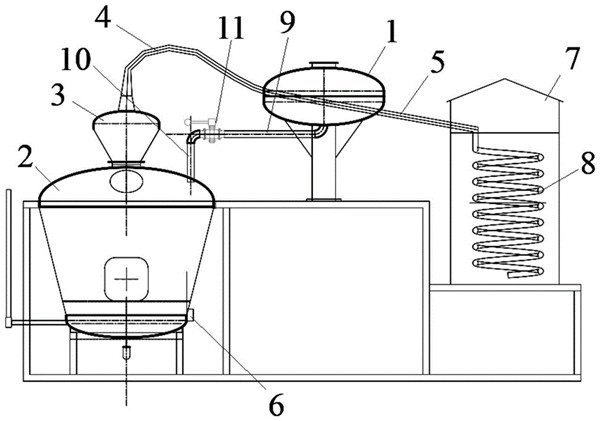Distilled wine is an alcoholic beverage with highly pure ethanol as the main ingredient. During the brewing process, distilled wine equipment is used to separate the ethanol in the fermentation liquid to achieve a highly concentrated effect. Distilled wine equipment is a key equipment in industrial production. This article will introduce the process principle of industrial distilled wine equipment.
I. Process overview of distilled wine equipment
Industrial distilled wine equipment usually consists of the following parts:
1. Fermentation tank: used for fermentation of raw materials, usually stainless steel or glass materials.
2. Distillation tower: separates the fermentation liquid into high-concentration ethanol and water.
3. Cooler: cools the distilled alcohol gas into liquid.
4. Collection tank: used to collect the distilled alcohol liquid.
In the process of distilled wine, the fermentation liquid in the fermentation tank is heated to convert it into gas, separated by a distillation tower, and the highly concentrated ethanol is distilled out, and cooled and condensed into liquid by a cooler, and finally collected in a collection tank.
According to the principle that the boiling point of alcohol is lower than that of water, the distillation is completed by heating the fermented mash to generate wine vapor, and then cooling the wine vapor to convert the vapor into wine liquid.
Entry-level: General spiral condensing distiller
The distiller is divided into two parts, one is the distillation pot and the other is the condenser. The function of the distillation pot is to heat the original wine into steam, and the function of the condenser is to condense the steam into liquid wine. The principle of distillation is: the boiling point of alcohol is lower than that of water. In the mixture of wine and water, the higher the alcohol content, the lower its boiling point. Therefore, during the heating process, the alcohol first evaporates and enters the condenser through a sealed pipe. The steam condenses into wine when it is condensed, achieving the effect of separating and concentrating alcohol.
The author's experience: The first distillation of fermented wine can obtain wine of about 45-55 degrees, the second distillation can obtain wine of 70-80 degrees, and the third distillation can obtain wine of more than 90 degrees.
Advanced: Charente distiller
Speaking of Charente distiller, we have to mention "Remy Martin". The Charente pot still is a brandy distillation equipment used for hundreds of years in the Cognac region of France, and is also used by famous wines such as Remy Martin. It is recognized as the most advanced brandy distillation equipment. The Charente pot still is mainly composed of three parts: the still, the preheater, and the serpentine condenser. The entire pot is made of copper. There are many purposes for copper: first, copper has good thermal conductivity, second, copper is a catalyst for certain esterification reactions, third, copper has good resistance to the acidity of the raw wine, and fourth, copper can make butyric acid, capric acid, capric acid, lauric acid, etc. form insoluble copper salts and precipitate, so that these acids with bad odors are removed. The copper plate should be very pure electrolytic copper, and the copper plate should be planed to make the pores in the metal dense, so that the surface of the pot is smoother and easier to clean. The pot body is a round pot, and the bottom of the pot should bulge inward to facilitate emptying. Due to direct fire heating, the bottom of the pot should have a certain thickness. One of the major features of the Charente distillation pot is the uniquely designed gooseneck cap, which is also called the column head. It is actually a distillation pot cover. One purpose is to prevent the "pot-fluttering" phenomenon during distillation. Another purpose is to make the steam of the distillate partially reflux here, thus forming a slight distillation effect. Its volume is generally 10% of the distillation pot container. Gooseneck caps of different sizes and shapes have different distillation effects, and thus the quality of the steamed products is also different. Generally speaking, the larger the gooseneck cap, the greater the distillation effect, the taste of the resulting product tends to be neutral, and the aroma is reduced. The Charente pot distillation pot generally uses an "onion-shaped" gooseneck cap, and there are also "olive-shaped" ones, but the latter has less aromatic products.
II. The process principle of distilled wine equipment
1. Distillation principle
Distillation is a physical method for separating different substances by using the difference in the evaporation temperature of different substances. It is based on the different vapor pressures of different substances at the same temperature, so that they become corresponding gas phases and liquid phases at their respective boiling point temperatures, thereby achieving the process purpose of separating substances.
2. Principle of distillation tower
For the two components of ethanol and water in the fermentation liquid, their boiling points are very similar, so a more efficient way is needed to separate them. At this time, the distillation tower becomes a necessary tool.
The distillation tower is a cylindrical container with several levels of plates. The fermentation liquid is added to the tower and then converted into gas by heating. In the distillation tower, the gas will cool and condense again. This is because the steam will encounter tiny protrusions on the bottom plate of the tower when it moves upward in the tower. These protrusions will cause part of the steam to cool and return to a liquid state. When the liquid falls on the plate, it will slowly penetrate into the texture of the plate until it reaches the liquid surface below. At this time, they will be heated again and converted into gas to start the next layer of separation process. This process is repeated until the standard alcohol quality is reached.

III. Principle of cooler
In the distillation tower, the vapor composed of a mixture of ethanol and water will pass through the cooler to cool and condense it into a liquid. The cooler is usually a water cooler connected to the distillation tower. In this way, the distilled alcohol gas is quickly cooled and condensed to form a liquid with a high concentration of alcohol.
3. Operation skills of distilled wine equipment
5. Control temperature: According to the operation requirements of each link, control the heating temperature to control the high concentration of the output.
6. Adjust the tower plate: Different alcohol yields require different numbers of plate plugs, adding or pulling out the tower plate.
7. Correct cleaning: Use appropriate pipes to clean the equipment to maintain its durability and the stability of alcohol quality.
IV. Waste treatment
During the distillation process, the waste generated usually consists of two parts: solid residue and waste liquid. Solid residue is usually some solid matter such as peels, which can be treated by physical methods. Waste liquid is a liquid containing a certain concentration of alcohol, which requires special treatment and complies with relevant pollutant treatment regulations.
V. Summary
This article introduces the process principles and operation skills of industrial distilled wine equipment, and analyzes the principles of distillation towers and coolers. In the production process of distilled wine, scientific and reasonable process flow and technical operation can better ensure the stability of distilled wine quality and improve production efficiency.
Plate Centrifuges Application
Esterification Reaction In Fragrance Synthesis
Fractionating Geranium Essential Oil
Contact: Project Manager
Phone: +86-18120438367
Tel: +86-18120438367
Email: info@tycoretech.com
Add: No. 1, Optics Valley Avenue, East Lake New Technology Development Zone, Wuhan, Hubei, China
We chat
